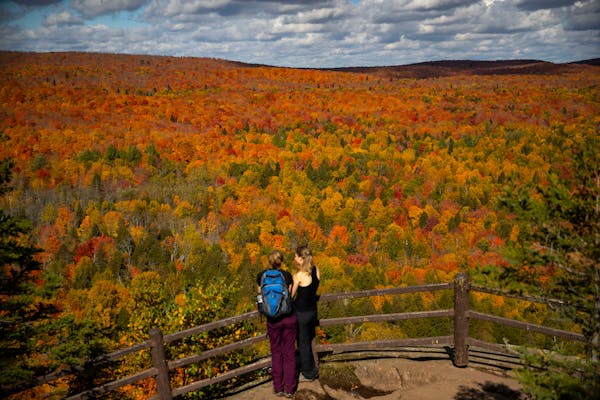DULUTH – Leaf peepers hoping for breathtaking explosions of color this fall might be disappointed thanks to Minnesota's extreme and historic drought, especially in the northern half of the state.
Severe drought throughout Minnesota has dried up rivers, lowered lake levels and contributed to multiple wildfires. And the lack of moisture typically dulls the vibrant yellows, oranges and reds seen in aspens, birches, poplars and maples.
Dry conditions also can often lead to premature shedding of leaves, meaning colors may peak earlier, experts say.
"It could be very quick," said Eric Otto, a Minnesota Department of Natural Resources forest health specialist in Grand Rapids. "When you have a drought, the part of the tree that loses moisture will shed first, and that's the leaf."
However, he said, recent rain Up North may help trees hold onto their leaves a little longer.
Some trees less resistant to drought, like balsam poplars, began changing color in northeastern Minnesota in August. In the popular leaf-viewing state parks of Jay Cooke, Gooseberry Falls, Split Rock Lighthouse and Cascade River, foliage is already 10 to 25% turned.
Timing is different throughout the state, Otto said, even without drought. Fall colors are typically earlier in northern Minnesota because weather there turns colder faster.
"But parts of southern Minnesota, like the southeast, have had adequate moisture," he said. "So there will be decent fall colors there."
How brightly hued a leaf becomes is tied to stored sugar. The slowing of chlorophyll production — which results in the reveal of fall colors — is happening more quickly because of low stores of sugar. That stems from less water reaching the canopy of a tree.
Trees may drop their leaves earlier as a form of self-preservation, said Steve Robertsen, an interpretation and education specialist with the Superior National Forest.
"The sooner they drop the leaves, the less water they lose through transpiration," he said, referring to the process of water movement through a plant, ending in evaporation.
Expect more tan, bronze and auburn colors in stressed trees. But oaks and elms, more resistant to drought because of their deep root systems, should still be colorful, Otto said.
Jessica Savage, an assistant professor in the University of Minnesota Duluth's biology department, runs a citizen science project that studies seasonal life cycles of various plants near Lake Superior. Many trees, such as those without deep roots, are changing colors two weeks earlier than last year, she said.
Along with producing more subtle tones, drought can sometimes force trees into a short burst of intense color, Savage said, "so it will be interesting to see if maples, for example, are more vibrant."
Peak color days will probably come in late September, as opposed to the first week or so in October. But what is considered "peak" is subjective, and depends on what trees and colors you want to see, Robertsen said, with maples often turning earlier and tamaracks last. Inland forests, too, like Finland State Forest, usually see a spectrum of color faster than the North Shore because of microclimate effects, he said.
Robertsen, who has been monitoring Superior National Forest fall colors for more than a decade, has taken a photo at the same spot at the same time on Honeymoon Bluff Trail near Grand Marais each of those years.
It always looks the same, he said, so he doesn't expect leaves to change "enormously early."
"I just don't think it's going to be as spectacular," he said.
Jana Hollingsworth • 218-508-2450

Want to share info with the Star Tribune? How to do it securely

'Safe recovery sites' would offer syringes, naloxone and more to people using drugs. The plan could be in peril.
New Minnesota GOP leaders seek peace with party's anti-establishment wing

Who is Republican Lisa Demuth, Minnesota's first House speaker of color?

